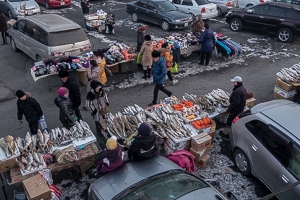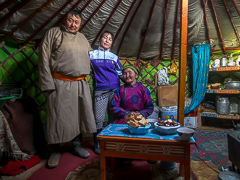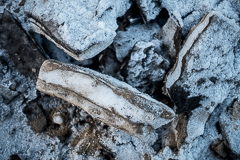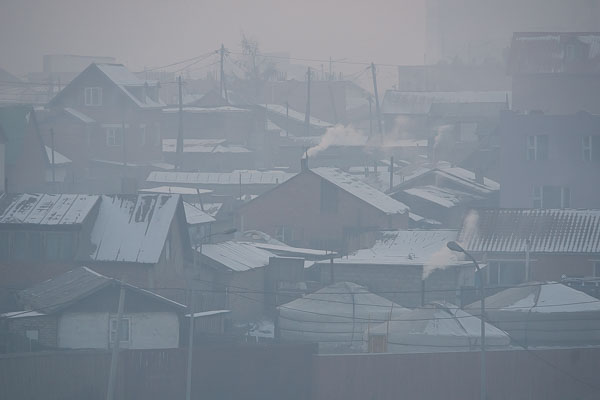Mechanics of Winter

Fish Sellers, Cold and Steady
Acclimation ° This morning it is –36°C (or –33°F) outside, not quite the coldest of the season, but about the same as is forecast for the next week. Both by dressing for the cold and by your body changing its metabolism to meet the daily challenge, it is quite possible to acclimate to these temperatures. I will never be like Mongolians I have seen working with blocks of ice bare-handed in this weather, but by this time of year fingers and toes have learned to do their jobs without complaining. A look around at those on the street is evidence that a lifetime of this adaption makes native Mongolians hardier, allowing some, though not all, Mongolians to routinely go without gloves or hats. Or at least that's what I imagine. As always, assumptions are risky. I asked a young visitor from Darkhan about the lightweight clothing she was wearing at -25°C. "How cold does it need to get before you wear gloves or a hat?"
"I lost them last year," she told me.
Cultural Adjustments ° Although climate change predictions are for weather that is warmer and drier, winter weather here still comes from Siberia. The traditional nomadic herding way of life has always depended on a fine balance of temperature and precipitation. Normally animals survive the cold if they have just the right amount of snowfall. A winter that kills off large numbers of livestock is called a zud. A white zud kills with heavy snowfall, preventing animals from grazing. A dry zud, a cold winter without snow, when water supplies are frozen over, kills herd animals by dehydration as surely as in a drought.

Modern Rural Herder
Especially for modern urban Mongolians, warmth is not the only reason for wearing these clothes. Dress versions are worn at any time, but especially at weddings and holidays, to show respect for Mongolian tradition.
A traditional Mongolian meal in winter is built around meat and fat, tempered with a little flour in the form of noodles (tsoivan) or dumplings (buuz, banch, or huushuur). Potatoes, carrots, onions, cabbage, and rutabaga are optional. This high-calorie diet is both useful, in warding off the cold, and lucky, because the Mongolian countryside in winter is not a good place to find vegetables. Horse meat is thought to be particularly healthy in winter, as are large cubes of fat from the floppy area near the tail of a sheep. It's a strategic diet for surviving a brutal winter outside, culturally attached to the idea of health. For Mongolians who live in apartments with central steam heat, who drive to work in heated Land Cruisers, this attachment is becoming a public health liability as a lean herding population comes more and more to resemble Americans in both cardiac disease and in their physical profile.
Learning Curve ° Genetic and cultural adaptions have developed over centuries. Chingis Khaan's warriors used their superior acclimation to winter to surprise European opponents eight centuries ago, taking advantage of frozen rivers for access that would be impossible in summer. Clearly his men didn't arrive in cars.
In a single generation Ulaanbaatar has quadrupled in population, and since 1980 the number of motor vehicles of all kinds in the entire country swelled from 32,200 to more than a quarter of a million. So while Mongolians have lots of experience with cold weather, their experience with roads and sidewalks is more recent. To those of us from the lake-effect region of the United States, where a meter of snow can fall overnight, the snow here is hardly noticeable until it falls on the polished granite slabs that have been chosen for use on sidewalks and stairs, making them as slippery as wet ice. When snowfall is significant the most common tool used to remove it is a broom. (I have never seen a snow plow in Mongolia.) When foot or car traffic compacts snow into ice, workers will resort to iron bars or a flat steel blade on a wooden handle, and then a shovel to remove the loose chunks. Once, in Sukhbaatar Square, I saw a worker with what I'd call a leaf blower, blowing light snow from the several acres of polished stone plaza along with a team of sweepers.

Coal Ash Oreo, Scraped from Sidewalk
Most of the other 30% live in apartments heated by steam produced in five power generation stations spread around the city, and delivered in large pairs of steel pipe insulated with asbestos, concrete, and various other material. The larger pipes run above ground where possible, with smaller trunks buried beneath streets and alleys. The pipes age, and sometimes fail. The heat to produce the steam comes from burning coal, a process that is many times more efficient than burning it in small stoves.
Other Anomalies ° The fact that everything is so cold causes the oddest things to freeze, and once frozen, to remain for much longer than you'd prefer. Though precipitation is uncommon at this time of year, streets become glazed with ice, the sum of the condensed water vapor drippings from exhaust pipes, in thick traffic brought to a crawl. Sidewalks are densely and until spring, permanently speckled with the phlegm of residents seeking to rid themselves of respiratory distress. Restaurant exhaust fans produce massive icicles, both from the top and accumulating on the ground. In ger areas without running water, much less drains or sewers, waste water of all sorts is heaved from yards. It usually soaks into the ground or runs into a ditch, but now accumulates in massive piles of ice striped brown, grey, green and other easily imaginable colors.
Liquid that accumulates this way will continue to expand until spring. Smaller amounts, including body fluids, will sublimate in a few days, but until then can be quite a sight—the former contents of a stomach stuck to a vertical wall, small piles of blood at the scene of a fight. Two young women were walking in front of me a few days ago as I passed through the small tunnel that leads out of our courtyard. Arm-in-arm as is common here, one of them slipped, feet in the air, landing on her tailbone. I made a note of the slippery spot, and when I got there realized that it began as a waist-high icicle on the wall beside me, running down and spreading across the sidewalk.
